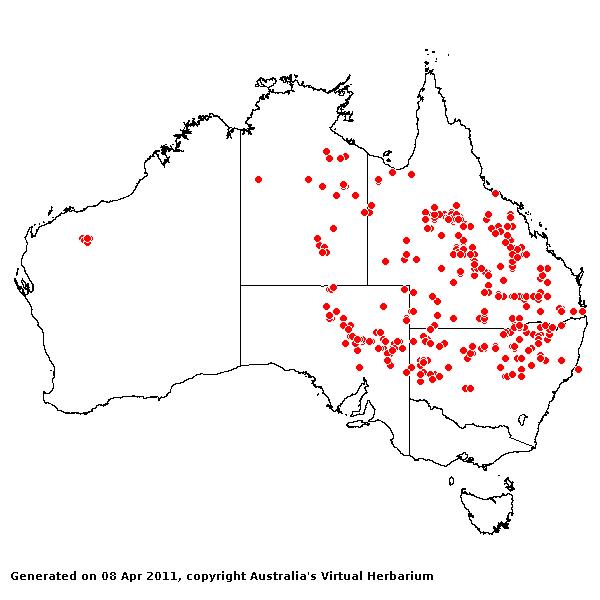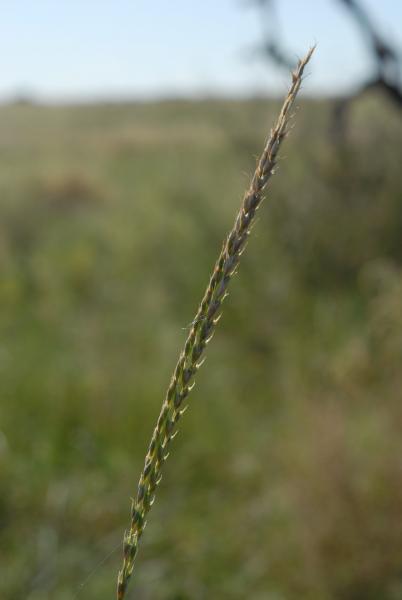Astrebla lappacea (Lindl.) Domin. Biblioth.
Bot. 85: 372 (1915).
Classification. (GPWG 2001) : Subfamily
Chloridoideae. Cynodonteae.
Basionym and/or
Replacement Name: Danthonia
lappacea Lindl., Three Exped. Australia 1: 309 (1838).
Type of Basionym or
Protologue Information: IT: Coll. Ukn. s.n., no date, Australia:
along the Bogan (US-0865614 (fragm. ex Cambridge)).
Recent synonyms:
Astrleba triticoides (Lindl.) F.Muell. ex Benth.
Key references
(books and floras): [1878] G.Bentham, Flora Australiensis 7 (602 as Astrebla
triticoides), [1952] C.A.Gardner, Flora of Western Australia 1 Gramineae
(204), [1981] M.Lazarides in J.Jessop (ed)., Flora of Central Australia
(448), [2002] D.Sharp & B.K.Simon, AusGrass, Grasses of Australia,
[2006] J.Jessop, G.R.M.Dashorst, F.M.James, Grasses of South Australia
(338), [2008] S.W.L.Jacobs, R.D.B.Walley & D.J.B.Wheeler, Grasses of New
South Wales (136).
Illustrations:
[1952] C.A.Gardner, Flora of Western Australia 1 Gramineae (203,
Pl. 60), [1983] J.C.Tothill & J.B.Hacker, Grasses of Southern Queensland
(118), [2005] K.Mallet (ed.), Flora of Australia 44B: Poaceae 3
(Fig. 81K-M), [2006] J.Jessop, G.R.M.Dashorst, F.M.James, Grasses of South
Australia (339. Fig. 271), [2008]
S.W.L.Jacobs, R.D.B.Whalley & D.J.B.Wheeler, Grasses of New South Wales,
4th edn (136).
Derivation: L.
lappa, burr; -acea, indicating resemblance. Lemmas shortly awned and
overlapping.
Habit.
Perennial. Rhizomes present, short. Culms erect or decumbent, 30–90 cm tall.
Lateral branches branched. Ligule a fringe of hairs. Leaf-blades 8–30 cm long,
4–5 mm wide.
Inflorescence.
Inflorescence solid, a raceme (spicate). Racemes 1–2, straight or arcuate, 5–30
cm long, 5–13 mm wide.
Spikelets.
Spikelets sessile. Fertile spikelets many flowered, with at least 2 fertile
florets (2–6), comprising 2–6 fertile floret(s), with diminished florets at the
apex, oblong, laterally compressed, 7–18 mm long.
Glumes. Glumes
dissimilar, thinner than fertile lemma. Lower glume lanceolate, scarious,
keeled, 1-keeled, 1–3(–7) -nerved. Upper glume ovate, 6.5–13 mm long, scarious,
without keels, 7–13 -nerved.
Florets.
Fertile lemma 2–4 mm long, without keel, 3 -nerved (in the body). Lemma surface
indumented. Lemma apex lobed, awned, 1 -awned. Median (principal) awn 4–14 mm
long overall. Anthers 3.
Continental
Distribution: Australasia.
Australian
Distribution: Western Australia, Northern Territory, South Australia,
Queensland, New South Wales.
Western Australia:
Fortescue, Carnarvon. Northern Territory: Darwin & Gulf, Barkly
Tableland, Central Australia South. South Australia: North-western, Lake
Eyre, Flinders Ranges, Eastern. Queensland: Burke, Darling Downs,
Gregory North, Leichhardt, Maranoa, Mitchell, North Kennedy, Port Curtis, South
Kennedy, Warrego, Gregory South. New South Wales: North-Western Slopes,
North-Western Plains, South-Western Plains, North Far Western Plains.
Notes.
Bentham misapplied Lindley's epithet lappacea to A. squarrosa q.v..
Occurs
in inland areas of eastern Australia N of 36°S excluding Cape York Penin. and
the channel country of SW Qld and NE S.A., with isolated reports from the Pilbara
area of W.A. It is sparsely present in the SE corner of the N.T. Only
localised, disjunct colonies of A lappacea occur in central Australia,
mainly in gilgais and depressions on cracking clay soils with A. pectinata
grasslands and Acacia cambagei (Gidgee). Astrebla lappacea
dominates large areas in central and north-central Qld while in southern Qld
and in N.S.W. it is sometimes locally dominant but more often mixed with A.
pectinata and other grasses such as Panicum, Bothriochloa and Aristida.
Flowers after rain.






